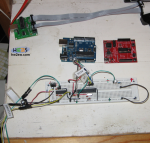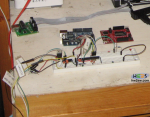
Why should we build an Arduino platform on breadboard?
A simple answer is: why not?
This is far away to be an idiot answer, because sometimes people wants to take account into electronics but doesn't know where to start from.
Differently from a pure theoretic book, the practice is a continuous discover of our potentialities.
Very few people has the ability to see in mind what a theory can onto the matter, while the opposite path is more widely available.
The strength of a good practical spirit is the ability to better understand the theory!
So... why not?
Arduino platforms are a very good starting point, especially the ones based on DIP (Dual In-line Package) integrated circuits, for the easily of management.
SMD (Surface Mount Device) components require a little bit more patience, as well as the ability and the right tools to sold: not very comfortable for our goals.
By going a bit deeper we must ask ourselves the real usefulness of a breadboard set up.

Look at the picture: we have an Arduino Duemilanove and a breadboard with some components onto it.
While the Arduino is compact and fully working, the other board occupies more space with the components set in a less ordered way.
Now... which board you'd use for your tests?
This is indeed the second important question, otherwise you could not consider the utility to spend some of your time to build an Arduino on breadboard.